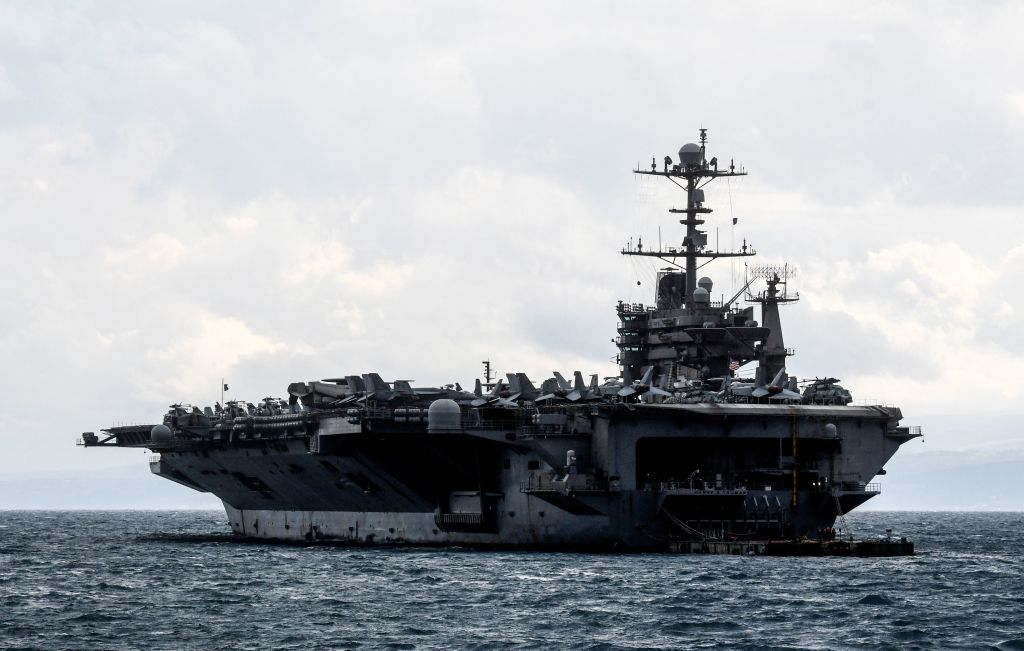How The U.S. Moves in Europe vs. How The U.S. Moves in Asia
Prepare for more U.S. troops permanently stationed in Europe. Meanwhile, the Transportation Command outlines some logistical problems for U.S. hegemony in the Pacific.



Edited by Sam Thielman
THE MILITARY COMMANDER of NATO, Air Force Gen. Tod Wolters, boasted to the Senate Armed Services Committee on Tuesday about the alliance's response to the Russian invasion of Ukraine. In his view, the European Defense Initiative, a Pentagon response to the 2014 Russian takeover of Crimea and the Donbass, has proven the merits of pre-positioning military equipment in Europe, of a larger U.S. force rotating in and out of Europe, of expanded Alliance training and increased U.S. mentorship to NATO militaries. Wolters marveled at how it had taken barely a week to move an entire armored Brigade Combat Team from the U.S. to Germany.
Then, after singing the praises of how rapidly the U.S. military proved it can deploy into Europe rotationally, Wolters set an expectation that the U.S. will keep a larger force on the European continent permanently.
SEN. ROGER WICKER: What is your recommendation as to more permanent U.S. forces [in Europe]?
GEN. WOLTERS: I think what we need to do from a U.S.-force perspective is look at what takes place in Europe following the completion of the Ukraine-Russia scenario, and examine the European [military] contributions, and based off the breadth and depth of the European contributions, be prepared to adjust the U.S. contributions. And my suspicion is, we're gonna still need more. And obviously there's always a mix between the requirement of permanent versus rotational [basing], and there are pluses and minuses of each one. We'll have to examine the European contributions to make a smart decision about where to go in the future. [emphasis mine]
Officials at the Pentagon have been hinting at this for a few weeks. For the record, Wolters clarified that there are now 100,000 U.S. troops in Europe, up from 60,000 before the invasion. They and their European counterparts form what Wolters described as a substantial military buildup up and down what Atlanticists have taken to calling the "Eastern Flank" of NATO in Europe.
A bolstered military presence on the ground, Wolters told the Senate, runs "from Tallinn in the north to Sofia in the south." Greater naval deployments have bolstered the NATO position "from the Arctic to the Aegean." In an unsubtle reference to how even Finland might now seek NATO accession, Wolters heralded a united, bolstered NATO "from Turkey in the southeast to Sweden, Norway and Finland in the north." In his prepared statement, Wolters said the alliance plans during an upcoming training exercise "to assemble a divisional formation on NATO's eastern flank for the first time since the end of the Cold War, conducting a multinational command post exercise with U.S. and multinational divisions and brigades operating under U.S. Army Europe leadership."
The wages of Vladimir Putin's aggression and miscalculation are now a far more united NATO—possibly an enlarged one, even without Ukrainian accession, thanks to alarm in Scandinavia—that has pushed its expanded military capabilities, including air defenses, closer to Russia's borders. They may next include a larger U.S. military presence on the European continent, no longer as a waystation for its Mideast deployments but again postured to confront Russia. Russia's adjustments to its military and diplomatic positions may or may not augur an offramp from the war, but they surely testify to how this giant strategic fuckup is now part of Putin's legacy.
Another way of summarizing Wolters' testimony is that the U.S. is expecting its crisis posture in Eastern Europe to become the backbone of its new normal there. It seems melodramatic to call it an Iron Curtain, but all of Wolters' (and others') talk about the rapid hardening of the Eastern Flank is giving an early picture of the array of a militarized Europe. Scary shit, considering the stakes.
But now I'm going to exercise some Danger Room muscles. Testifying beside Wolters was Air Force Gen. Jacqueline Van Ovost, the commander of U.S. Transportation Command (TRANSCOM). While Wolters showed how smoothly U.S. hard power flows into Europe, Van Ovost outlined how it might flow less smoothly into Asia, the other arena of U.S. imperial competition.
FOREVER WARS is part of the Discontents Substack cartel, and with cartelization comes benefits. Subscribe to Forever Wars for a year and receive six FREE months of two of our affiliated newsletters, Welcome To Hell World by Luke O’Neil and Derek Davidson’s Foreign Exchanges. Both of them are excellent, and you’ll get them both at the subscriber tier. Subscribe today! And remember: REIGN OF TERROR is on sale!
NO ONE CARES about TRANSCOM because it doesn’t fight wars and is fucking boring. But its mandate is to move the U.S. military and its stuff from place to place, particularly in a crisis. A global empire depends not only on forward positioning but on mobility. You've probably heard the quote, attributed to Omar Bradley, that amateurs study strategy and professionals study logistics.
Van Ovost seemed a bit overzealous, in the way that combatant commanders often are when trying to get legislators to fund their priorities. But her testimony painted a picture of the logistical difficulties the U.S. may encounter, should its Cold War with China compel it to bolster an Asian ally or proxy in a clash with the People's Liberation Army or the PLA Navy.
Remember how Wolters praised the equipment pre-positioning under the European Defense Initiative that permitted the rapid deployment of the heavy brigade? That's not going to happen in Asia, Van Ovost said. TRANSCOM's strategy to aid the warfighting command for Asia, awkwardly called INDOPACOM, is to avoid "a large single location where we could stack up our logistics." The idea is to avoid having set locations that can be schwacked by Chinese missiles (and would place various ports used by the U.S. in Asia into delicate political positions). That means seabasing. "Keep it on the move so it won't be a target," Van Ovost explained.
The problem there is that the Navy's sealift fleet "is critical to the execution of our plans." It moves "90 percent of our capacity," Van Ovost said, which, again, makes sense when considering the map of the Pacific and the lack of major Asian landbases used by the U.S. relative to Europe. But Van Ovost warned that within the next decade, 70 percent of the Navy's sealift-relevant ships are set for retirement and pleaded for "recapitalization" to replace them. Cold Wars are good for shipyards and better still for defense contractor C-suites.
But then there's an added complication. It's one Van Ovost didn't put into this context, but the implications speak for themselves. If you're conducting a distributed logistical movement across a vast ocean, staged from island airstrips, friendly ports, and seabases, then your communications infrastructure at sea, the backbone of maritime command and control, is going to be put to the test. Van Ovost described TRANSCOM as "inextricably linked" to the private transportation industry. And since the military lacks the authority to patrol the data networks of private industry, TRANSCOM has a soft digital underbelly. "Cyber is an area of significant vulnerability for TRANSCOM," Van Ovost testified. (By contrast, Wolters boasted of how well NATO has integrated its cyber defenses.)
I'm sure you don't need me to point out the problem. The PLA's digital capabilities are exquisite. If the U.S. military's logistical network relevant to the Pacific is by necessity distributed and maintains uneven cybersecurity, then China has obvious opportunities to exploit those vulnerabilities. Van Ovost's comments about sealift retirements suggest that those vulnerabilities, physical and digital, are going to persist throughout the 2020s and will be expensive to redress.
All this is to say that, beyond the banal geographic differences, U.S. military mobilization to Eastern Europe is straightforward and routinized in a way that it simply won't be in the Pacific. There are no certainties in this new Cold War against a rising superpower whose economy is enmeshed with America's, except that the defense industry wins.
OK, SO WHEN I SAY THIS IS A DANGER ROOM-STYLE POST, what I mean is I am trying to get granular about military developments, not endorse them or the strategies they implement. I'm trying to pop the hood and look at what's going on under it. Getting granular can sometimes mean analyzing a military issue on its own terms. That does not mean those are the only terms on which they should be viewed. It means they're the tools that help you determine what is happening in the moment, not that they're the tools to help you determine what should happen in or beyond the moment.
I wish every Danger Room piece I ever wrote for WIRED carried that caveat. Not that it would have stopped misreadings, but it would have contextualized what I was trying to do when I had that job.

